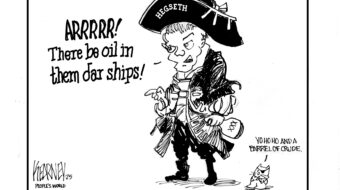
The nuclear clock ticked ever closer to midnight Thursday when Gen. Charles Brown, Jr., the chairman of the Joint Chiefs of Staff, said that U.S. and allied troops, under the umbrella of NATO, will get into Ukraine, “eventually, over time.” He made the remarks as reports were released in media around the world that NATO is considering dispatching soldiers to “help” Ukraine.
Thus far, the Biden administration has officially resisted making statements like that. Such a move would increase the danger of head-on conflict between the two largest nuclear powers in the world. The administration has supported, however, an enormous war budget of a trillion dollars, with a $60 billion add-on recently for more weapons for Ukraine. That war is widely seen as a proxy war between the U.S. and Russia.
Since the beginning of the war in Ukraine, Americans have been told, essentially, that they will pay for the weapons while the Ukrainians do the dying. If NATO troops end up in Ukraine, which is what the top Pentagon general is saying, U.S. and Russian soldiers could find themselves facing one another directly on the battlefield.
That, on top of Poland’s request two months ago for U.S. nuclear weapons to be stationed in their country near the Russian border cannot do anything but push the world closer to the brink of potential disaster.
Counting both Ukrainians and Russians killed since the full-scale Russian invasion of that country began three years ago, it’s estimated that hundreds of thousands have been killed. While the dead pile up the coffins containing boys are shipped back to Kiev and Moscow, U.S. arms companies have been raking in a fortune over the war.
The armament makers are using Ukraine as a testing ground for all kinds of new and deadly weapons, including ones they hope to use in future profit-making wars. No one has an accurate read on the extent to which Ukrainian oligarchs have joined in on the profit-making connected to the free reign given to arms companies in their country.

Sabotaged peace talks
On the peace front, Russian President Vladimir Putin said Thursday that he appreciated China’s continuing attempts to push for a ceasefire and negotiations as a solution to the war. While visiting Moscow, President Xi Jinping said his country will continue to push the 12-point peace plan it announced last year.
That plan was rejected by the U.S., despite statements from the Ukrainian government that it found some parts useful. This week, the Biden administration rejected another proposal from China on a separate issue, an attempt to get the U.S. to agree to no-first-use of nuclear weapons.
It’s all part of a repeating pattern. Since the beginning of the Ukraine war, the U.S. has, at times by itself, and at other times with the aid of the U.K. and others, sabotaged numerous attempts by the parties to begin peace talks, telling the rulers in Ukraine that the NATO powers will supply them everything needed to fight the Russians.
Russia began its invasion in February 2022 after the U.S. convinced Ukraine to make no promise that it would stay out of the NATO alliance, which had already moved its troops, including U.S. troops, into countries lining the border with Russia. Before that invasion, the coup government in Kiev spent the years since 2014 sending the most right-wing elements of its armed forces into the Eastern parts of its country, where they killed some 15,000 Russian-speaking Ukrainians.
The Ukrainian state that exists today was established with U.S. backing in 2014. It overthrew the corrupt albeit legitimately elected government headed by President Viktor Yanukovych. That government earned the disdain of the U.S. when it resisted austerity demands made by the E.U. in exchange for economic investment. Instead, the Yanukovych government decided it would step up economic cooperation with Russia and avoid the E.U. austerity dictates.
At that time, there was extensive trade between Russia and the E.U., trade that big U.S. corporations, particularly fossil fuel companies, wanted to end so they could step in and rake in the money instead. The U.S., it is now widely assumed, was likely behind the blowing up of jointly built Russian-German pipelines supplying energy to Western Europe.
Months before, President Biden had assured reporters in Europe that the U.S. would “take care” of the pipelines to end Russian economic benefit. Efforts to investigate the sabotage have been slowed down or had their findings suppressed by many of the major European powers.
Now, when there is widespread recognition that it is past time for negotiations to begin to end the war, the U.S., in statements from its top general and others, is signaling that it intends to send troops into Ukraine to directly engage the Russians. The announcement also comes just as Russia has been making major gains on the battlefield in eastern Ukraine.
Back in Russia, Victory Day, the biggest annual holiday in that country, was celebrated on May 9. On that date, the defeat of the Nazis by the Soviet Union in 1945 is remembered. In Victory Park in Moscow, U.S.-made M1A1 Abrams tanks captured in Ukraine are now on display alongside German weapons captured from the Nazis in World War II.
Captured Leopard tanks sent to Ukraine earlier this year by Germany are also on display. When the Abrams and Leopard tanks were shipped to Ukraine months ago, they were heralded as weapons that would move Ukraine closer than ever to victory.
Media accomplices
The New York Times has been banging the war drums recently, including constantly reminding readers of the lack of democracy in Russia. The paper’s editors and reporters say nothing about the banning of all opposition parties and news media in Ukraine nor about laws that make most trade unions in the country illegal.
The Times excuses the plans to send in U.S. and other troops under the umbrella of NATO by reporting that the move is designed to relieve “manpower shortages” on the battlefield. Those “shortages” result from massive numbers of Ukrainians being killed and the failure of the government to find replacements.
Ukrainians in their droves are apparently rejecting the attempts to continue this war by refusing to serve. Government patrols have resorted to cruising the streets and seizing people at gunpoint, forcing them, totally untrained, into the army and sending them to the front lines. Many of them see their own government as simply sending them to their death. They do not believe that by going to fight they are saving democracy, which is what the U.S. government and corporate media tell Americans.
The Biden administration has defended the war by describing it as a “good deal” for Americans. The huge military budget, the Biden administration has said, will create many jobs here at home for people making weapons. When Americans start to die in Ukraine on the battlefield, the “good deal” argument will likely become a lot less convincing.
The other lie Americans have been told is that by pouring tens of millions of dollars into the proxy war in Ukraine, Russia will likely go down to defeat at the hands of Ukrainians determined to save their homeland. The recent advances by Russian forces in the east and the deteriorating position of the Ukrainian military undermine that argument.

“We’ll get there eventually”
The Ukrainian government says it needs at least 150,000 new troops on its northern borders.
When asked if NATO troops could fill that gap, Pentagon Gen. Brown’s answer of “We’ll get there eventually” signals plans are in the works for a major escalation of U.S. involvement. Even just sending in only NATO trainers or advisers would create new U.S. obligations under the NATO treaty.
If those trainers were attacked by Russians, the U.S. would have to come to their “defense.” It could provide a justification for sending in U.S. warplanes, for example. Brown admitted that this was the case and said the U.S. would always abide by its NATO treaty obligations.
Even as Brown was making a promise of greater involvement, the Biden administration was reiterating its official position Thursday that no U.S. troops would go to die in Ukraine. The top U.S. general and the White House thus appear to be taking two positions simultaneously on the issue—the U.S. government supposedly opposes sending troops but also says they will get there eventually. That kind of duplicity is, in itself, dangerous.
Adding to the dangerous situation is the continued insistence by French President Emmanuel Macron that “nothing” should be ruled out when it comes to NATO intervention in Ukraine. Remarks like his give cover to the U.S., which can always claim it was not the first to move in this new dangerous direction but that it was following the wishes of its NATO allies. Macron first announced his position in February.
The U.S. has frequently said it did not want to dispatch certain weapons to Ukraine but then changed its mind after allies made the first move.
The right-wing government of Estonia has chimed in, as well, saying it might send troops into western Ukraine. Lithuania’s foreign minister said his country would join in, too, and last week, bragged in an interview with The Guardian that his country had troops in Ukraine even before the war began.
As for Germany, its support for the war effort brings back memories of times past. The New York Times Friday published a photo showing a long line of German tanks rumbling along a highway, heading toward Poland. In the caption, the editors failed to mention it was one of many west-to-east highways originally constructed by Hitler in the 1930s specifically for the purpose of moving tanks and troops into position to invade the Soviet Union.
U.S. military leaders continue to argue that the placement of NATO trainers in Ukraine comes with benefits because it would enable the U.S. to better assess the Ukrainian’s “enemy” positions and plans.
Washington war hawks
But the loudest voices calling for an escalation of NATO’s direct involvement continue to come from Washington.
Another war hawk not heard from lately re-surfaced just this week. Evelyn Farkas, formerly the top Pentagon official for Ukraine under the Obama administration, reiterated her support Thursday for NATO troops going into Ukraine and admitted that U.S. troops were actually in the country years ago before the Russians moved into Crimea.
“Remember, when Russia first invaded Ukraine in 2014, we sent increased (many were already there) numbers of troops. We kept rotating them in all the way to 2012 when we got spooked and withdrew them. It shouldn’t surprise anyone that now with troop shortages, NATO has to consider sending in troops,” Farkas said.
Alexander Vindman, the well-known retired U.S. Army colonel and native of the Soviet Union, added his voice to the war party. He said it was “malpractice” to send Ukraine large amounts of arms but not the personnel needed to use them properly.
If it all results in World War III, Vindman, Farkas, Brown, and the rest may not be in a position to comment further.
As with all op-ed and news-analytical articles published by People’s World, the views above are those of the author.
We hope you appreciated this article. At People’s World, we believe news and information should be free and accessible to all, but we need your help. Our journalism is free of corporate influence and paywalls because we are totally reader-supported. Only you, our readers and supporters, make this possible. If you enjoy reading People’s World and the stories we bring you, please support our work by donating or becoming a monthly sustainer today. Thank you!









